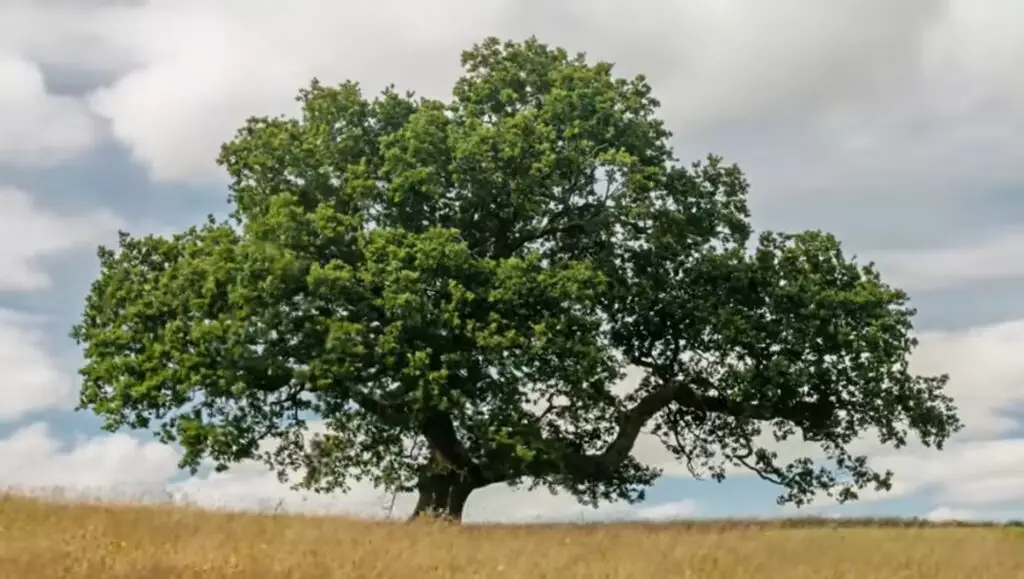Oak trees are a majestic and iconic species found throughout many regions of the world. There are over 600 different species of oak trees, and they can be found in a wide variety of habitats, from forests to grasslands and even urban areas. In this article, we will explore the many uses, ecological significance, and cultural importance of oak trees.
Uses of Oak Trees:
Oak trees have a wide variety of uses, including for their wood, food, and medicinal properties. Oak wood is highly valued for its strength, durability, and beauty, and is commonly used in furniture, flooring, and construction.
The bark and acorns of some species of oak are used in traditional medicine to treat a range of ailments, including diarrhea and fever. In addition, oak trees provide an important source of food for many wildlife species, including deer, squirrels, and birds.
Types of Oak Trees
There are over 600 different species of oak trees, but here are some of the most common types of oak trees found in different parts of the world:
-
White Oak (Quercus alba): This tree is found in North America and is one of the most common species of oak. It is known for its strong and durable wood, which is used in furniture and flooring.
-
Red Oak (Quercus rubra): Another common species found in North America, the red oak is known for its strong wood and vibrant autumn color.
-
English Oak (Quercus robur): This species is native to Europe and is known for its distinctive lobed leaves and strong wood. It has played an important role in English culture for centuries and is often associated with royalty.
-
Cork Oak (Quercus suber): This species is found in the Mediterranean region and is known for its thick, corky bark, which is harvested to make wine corks, flooring, and other products.
-
Live Oak (Quercus virginiana): Found in the southeastern United States, the live oak is known for its broad, spreading branches and evergreen leaves. It is often used in landscaping and as a shade tree.
-
Swamp White Oak (Quercus bicolor): This species is found in wetland areas in North America and is known for its white, peeling bark and tolerance to wet soils.
-
Japanese Oak (Quercus dentata): Native to Japan and Korea, this species is known for its large leaves and strong, durable wood.
These are just a few of the many types of oak trees found throughout the world, each with its unique characteristics and ecological significance.
Oak Trees Life
Oak trees are known for their longevity and can live for hundreds of years, with some species living for over a thousand years. The lifespan of an oak tree depends on various factors, including its species, environmental conditions, and disease or pest pressure.
On average, oak trees can live for 200-300 years, but some species have been known to live for much longer. For example, the white oak tree (Quercus alba) can live for up to 500 years, while the Bur Oak (Quercus macrocarpa) can live for up to 400 years. The English oak (Quercus robur) has been known to live for over a thousand years in some cases.
The growth rate of oak trees is relatively slow, especially in their early years. It can take several decades for an oak tree to reach maturity and start producing acorns. As they grow older, oak trees become more resistant to disease and pests, and their trunks become thicker and more robust.
Overall, oak trees are known for their longevity and are an important part of many ecosystems, providing ecological, cultural, and economic benefits for many generations to come.
White Oak Trees
White oak trees (Quercus alba) are a species of oak tree that are native to North America. They are known for their hard and durable wood, which has been used for centuries in the construction of furniture, barrels, and flooring.
White oak trees can grow up to 100 feet tall and have a wide, rounded crown. Their leaves are lobed and can grow up to 9 inches long, turning a reddish-brown color in the fall. White oak trees are also known for their acorns, which are larger and sweeter than those of other oak species and are an important food source for wildlife.
White oaks are relatively slow-growing and can take several decades to reach maturity. They prefer well-drained soil and full sun to partial shade, and are commonly found in mixed deciduous forests in the eastern United States.
In addition to their economic importance, white oak trees are also ecologically significant, providing habitat and food for a variety of wildlife species, including deer, squirrels, and birds. They also help to improve soil quality, prevent erosion, and sequester carbon dioxide from the atmosphere, making them an important part of many ecosystems.
Red Oak Trees
Red oak trees (Quercus rubra) are a species of oak tree native to eastern North America. They are known for their strong and durable wood, which has been used for centuries in construction, furniture-making, and flooring.
Red oak trees can grow up to 90 feet tall and have a straight, cylindrical trunk. Their leaves are pointed and lobed, turning a brilliant red color in the fall. Red oaks produce acorns that are smaller than those of the white oak tree but are an important food source for wildlife.
Red oak trees are relatively fast-growing and can reach maturity in 20-25 years. They prefer well-drained soil and full sun to partial shade, and are commonly found in mixed deciduous forests throughout their range.
In addition to their economic importance, red oak trees are also ecologically significant, providing habitat and food for a variety of wildlife species. They help to improve soil quality, prevent erosion, and sequester carbon dioxide from the atmosphere, making them an important part of many ecosystems. However, like many other oak species, red oak trees are susceptible to a variety of pests and diseases, including oak wilt and gypsy moth infestations, which can impact their health and longevity.
Fast Growing Oak Trees
Oak trees are generally known for their slow growth, but some species are faster-growing than others. Here are a few examples of oak species that are relatively fast-growing:
-
Nuttall Oak (Quercus nuttallii) – This oak species are native to the southeastern United States and can grow up to 3 feet per year in its early years. It can reach a mature height of up to 100 feet and prefers moist, well-drained soil.
-
Sawtooth Oak (Quercus acutissima) – This oak species are native to eastern Asia and is known for its rapid growth rate, with some specimens growing up to 4 feet per year. It can reach a mature height of up to 50 feet and prefers well-drained soil and full sun.
-
Shumard Oak (Quercus shumardii) – This oak species is native to the southeastern United States and can grow up to 2 feet per year in its early years. It can reach a mature height of up to 100 feet and prefers well-drained soil and full sun to partial shade.
It’s important to note that even fast-growing oak trees still have a relatively slow growth rate compared to other tree species. Additionally, fast-growing oak trees may have weaker wood than slower-growing trees, making them more susceptible to breakage in severe weather conditions.
Ecological Significance:
Oaks are an important component of many ecosystems, providing a range of ecological services. They are known as a keystone species, meaning that they play a critical role in maintaining the structure and function of their ecosystems. Oak trees are known to support a wide range of wildlife species, including insects, birds, and mammals. In addition, oak trees are known to improve soil quality and prevent erosion, making them important for land conservation.
Cultural Importance:
Oak trees have played an important role in human culture for thousands of years. They have been used in many different cultures for their spiritual and symbolic significance, and have been associated with strength, wisdom, and longevity.
In addition, oak trees have been an important source of food, medicine, and building materials for many cultures throughout history. In the United States, the oak tree is the national tree and has been used in many national symbols, including the Great Seal of the United States.
Conservation:
Despite their ecological and cultural significance, many species of oak trees are threatened by habitat loss, climate change, and invasive species. In many regions, oak forests are being converted to other land uses, such as agriculture and urban development, which can lead to significant declines in oak tree populations. To address these threats, conservation efforts are needed to protect and restore oak forests and to promote sustainable land-use practices that support these valuable trees.
In conclusion, oak trees are an important and iconic species that provide a range of ecological, cultural, and economic benefits. They play a critical role in maintaining the health and diversity of many ecosystems and have been an important part of human culture for thousands of years. It is essential to protect and conserve oak trees to ensure that they continue to provide these important benefits for future generations.







